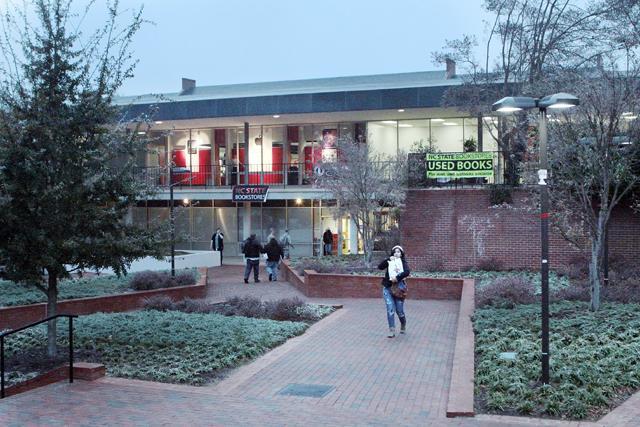 " />
" />
© 2011 NCSU Student Media
Valeria Lozano, a freshman in statistics, leaves the bookstore after purchasing her textbooks for the new semester. "It's nice to have a bookstore that's closer, but it really depends on what they want to put in the new store," Lozano said, in reference to Goodnight, Raleigh!'s campaign to save the bookstore from demolition. Photo by Danielle Neujahr
Everyone has that place from the past that evokes memories, distinct and fresh, as if you were only there yesterday. Everyone has experienced the sharp pain of loss at finding something else has replaced their haven of nostalgia.
One Raleigh website wants to stop that from happening here on campus.
“When something that’s history is about to be lost, you try to do everything you can to save it,” said John Morris, publisher for Goodnight, Raleigh! and the head of the Save the Bookstore protest.
Goodnight, Raleigh! is an online magazine that publishes photos of the city at night, a side of Raleigh that is not often seen. They also provide back stories of the subjects of these photographs, connecting their readers to places and people they otherwise would not be exposed to.
Always focused on historical preservation, one of the blog’s aims is to expose people to the upcoming demolition of what they consider to be an important historical building — the Campus Bookstore.
“I’d like for students to be more aware of the history of the College of Design professors that gained national prominence and were directly responsible for shaping the city of Raleigh in to what it is today,” Morris said.
Morris explained that the building was designed by Milton Small, who taught for a short time at the College of Design before going on to design some important buildings in Raleigh, including the WRAL Studios building, located on Western Boulevard near the University.
“[The bookstore] represents when the College of Design came into national prominence,” Morris said. “Knocking down a building that was a part of that [makes] it seems like we’re sweeping history under the rug.”
Morris discussed the unique architectural features of the bookstore, such as the interesting brick pattern that deviates from the normal pattern on most of the University’s buildings. He also highlighted the wavy canopy that covers the walkway, and described the building as an “atomic, space-age” type building.
“It’s small things like that that people don’t notice. If you stop and look at it, there are some really unique features,” Morris said.
Morris said the walkway that encircles the building is another element absent on other buildings on campus.
“You get to experience the building as you walk around it,” he said.
While many alumni have commented on Morris’ article about saving the bookstore, expressing their concern and outrage at the demolition, most students seem to understand the need for the change.
“I think in the end it will be worth it,” Jewel Williams, a senior in English, said. “There are so many universities that have better student centers than we do. I think we should use the time to make it better.”
At the bookstore itself, the general consensus was much the same.
“It’s already pretty much set in stone,” Shahna Jones, a senior in social work, said. “The cons would have to outweigh the pros.”
“I understand why a lot of alumni might be against it,” Amy Issichopoulos, a freshman in management, added.
Morris proposed instead to use the building for something else—much like when D.H. Hill Library was moved from Brooks Hall in the 1940s, and Brooks Hall was left standing. The purpose of the building merely changed.
“I understand that there needs to be a new bookstore. It’s just that [the building] could be used for something else,” Morris said.
While Morris’ main goal is the preservation of the bookstore, he also hopes that the protest will bring awareness to the historical value of the building and spark a debate among students.
“At this point, Talley’s going to happen. And that’s fine. But we don’t have to erase the past to improve Talley,” Morris said.
Morris ultimately wants students to have their voices heard, and to value the bookstore as more than just a place to get textbooks and school supplies.
“I guess what I’m hoping the most is that students will notice it before it’s gone,” Morris said. “And that they will see it and appreciate it for what it is.”